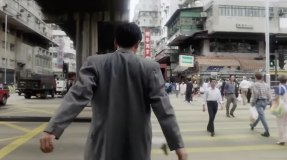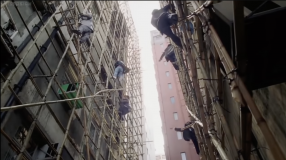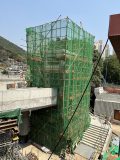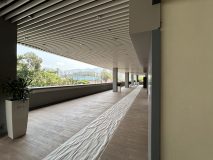Script
Introduction
W: Hi, today we’ll be talking about the movie ‘God of Gamblers’, starring Chow Yun-Fat and Andy Lau,. Filmed in 1989 by Wong Jing, it has since been an icon of the Golden Age HK cinema.
M: This film follows the protagonist Ko Chun (played by Chow), known as the ‘God of Gamblers’ for his world-renowned gambling skills, who lost his memories after hitting his head due to a practical joke played on him by Dou Zai (played by Andy Lau).
W: Throughout the film Ko and Dou Zai develops a love-hate relationship as Andy discovers Chow’s exceptional gambling powers despite Ko being amnesic, and attempts to exploit Ko’s abilities for his own personal gains. Yet this led to the event in which Andy tried to abandon Ko at an MTR exit, but eventually discovered that he didn’t have the heart to. That was the turning point to their relationship and eventually Dou Zai helped Ko regained his status as the ‘God of Gamblers’.
Techniques
M: As for the cinematography, ‘God of Gamblers’ employed a lot of film techniques that are characteristic of the Golden Age HK Films. Techniques include using wide angles to encompass the cramp urban space, filming the closeness of society yet how distant each individual seemed to be. The film also incorporated a lot of Chinese Martial Art styled combat scenes, such as the bodyguard Dragon fighting against various thugs on the train. In the film, particular hand movements are separated and accentuated in every body interaction, exemplifying the form and complexity of East Asian Martial Art.
Architecture and Film
W: As for the architecture, the film sets its scene within a wide array of distinct urban landscapes that helps create the desired atmosphere and facilitates character development. A few particular examples include the Prince Edward MTR Exits, Bamboo Scaffoldings on HK highrises, and old-style HK malls (Shatin Lucky Plaza).

M: The first scene here before the exit of Prince Edward Station depicts Andy’s attempt to abandon Chow. In the film, the old residential buildings, moving vehicles and pedestrians all add up to show how fast-paced the city was.
W: Together with a close-up tracking shot of Andy walking away from Chow, these features help to reflect the inner thoughts and emotions of Andy’s character when he abandoned Chow, that is he could not bear to leave Chow alone in the street, and further his rising doubt towards the morally ambiguous act of trying to get rid of him.
M: Besides the environmental intensity as a method to build tension, the scene also made use of architectural change to exemplify the change in atmosphere, as to highlight that the major obstacle for the protagonists have been resolved in that scene. First, the director here used arc shots and dutch angles to show the loneliness and helplessness of Chow. For Chow, the surrounding architecture of cramped blocks of Tong Laus exemplifies a sort of entrapment, in which he is trapped in a seemingly hopeless situation that is not of his own choice.
W: In the next scene, however, Andy found Chow in a rather distant and open area, where there were more greens, less buildings, less traffic, to which the architecture there shows a sign of being relived and a similar emotion of losing something important but recovering it later in Andy’s heart.
M: Next, we come to a scene where Andy Lau was chased by a group of thugs on some Bamboo Scaffoldings. Here, the director employed a tracking shot to follow the chase between Andy Lau and other thugs on the scaffolding. We could precisely see the way Andy hopped around the bamboo sticks in a playful yet tense manner, which elevates a sense of almost hysteria because, at any time, Andy could have fallen from the 5-stories high of scaffolding and been hurt.

W: To add to that, there are also uses of wide angle showing the entirety of the building and the bamboo scaffolding where you can see how the bamboo sticks are connected. So there are poles erected vertically to support the rest of the structure, horizontal ones that support the weight of the workers, and two sticks forming a symbol of a cross that strengthen the integrity of the network.
M: Nowadays, which is over 30 years from the film, bamboo scaffoldings are still used as the prevalent method for construction. The director could’ve easily made a staircase chase scene, but instead decided to have the chase scene shot on scaffoldings.
W: On one hand this is much more exciting as the prospect of death for the characters is much real, this would help increase the intensity of the film and keep the audience engaged.

(Continued) W: Yet furthermore, this also allows the director to present bamboo scaffolding on film, as the exemplification of the HK spirit. Material that are flimsy and cheap, yet somehow are unbreakable. In the ones we’ve seen in Shatin, the same bamboo scaffoldings are used to construct multistory buildings. Yet not much as changed as of the outward make or design of these scaffoldings. It has remained as an integral part of construction and in the culture of Hong Kong.
M: Lastly, for the particular scene where the shootout occurs, the director used first-person POV shots to simulate the movement of characters. To further increase the realism in the shot, they even had shaky cameras so that you could sort of experience, for example, how frantically Chow was escaping from the thugs and the way Andy’s team dodged bullets while advancing on the stairs. There are also close-up shots of the characters to accentuate the anxious emotions during the shootout.

W: Upon the arrival of the film site, we have observed that the structure of the plaza remains more or less unchanged. You can still see a similar reel of fire hose and the same staircase where Andy and his team began the shootout. The particular section of the plaza is under construction and the design, including tiles and pillars, has changed from square concrete bricks into some stylish wooden tiles, from cylindrical pillars to square ones.

M: To add to that, the surrounding landscape had also been developed over time, where it used to be trees and mountains, but now buildings after buildings arise. It really shows how urbanization and modernity influenced our city to such an extent.
W: It is astounding to note the drastic differences between how we used to perceive Shatin, that is to say 30 years ago as depicted in the film, as somewhere rural. To now, it has become an entire commercial centre with luxurious shops and high-end restaurants everywhere. The original architecture of the cylindrical pillars and the bricked floors did create a subtle sense of grandiose, which probably was why the director chose this location in the first place.
M: We had a glimpse of it since there still remains two cylindrical pillars at one end of the plaza. This sense is entirely lost in the new architectural design when we visited, the new pillars was much thinner and had corners, which erased the sense of grandness that once exemplified by the previous design. As such, I’m not sure whether the director would still choose this location to film the shootout if it were to be filmed in this day and age. The old architecture of HK, in the name of urban renewal, is being slowly erased as we speak.
Conclusion
W: Through comparing and contrasting, we could observe many differences in terms of culture in the 80s and culture in the present. The mere depiction of Hong Kong in the film has changed a lot, with more elements of modernity and complexity in the architecture. Throughout the entire film, we also appreciate how directors put much effort into filming the scenes so as to give us a glimpse of how the character was feeling and behaving or that how the architecture, the buildings, and the surroundings were back were then.
M: As for the architecture, through the film, we see how the HK urban landscape used to be before the handover, therefore preserving it. Yet, these architectural features are slowly being replaced in the course of urban development. The old Tong Laus were still there when we visit Prince Edward, but slowly these Tong Laus will eventually be renovated or even taken down in favour for high-rise, high-capacity residential towers. As they have been. Bamboo Scaffoldings may also slowly be replaced, as it may be structurally unsound compared to steel structures, and the price for steel has also decreased over the decades.
W: Perhaps the cityscape in the movie, and HK as we know it, will change into something else someday. This is done in the name of progress, in the name of urban renewal and development. But perhaps what was sacrificed is something that is unquantifiable and intangible. We need to do more to preserve HK’s architecture and culture.
Choi Long Hei Matthew (M): 3036060769, and; Lam Chun Wai, Wilson (W): 3036050556
Note to reference:
Since the system of this blog automatically scales down the dimensions of the stills included in the post, it is hard to look at the pictures taken out of the film or from the film site clearly. Here is an attachment of a pdf file, including all 5 stills for your reference.
Your podcast has demonstrated a good level of understanding to the context and the filming techniques employed by the director. The analysis on different camera angles, the depiction of the cityscape, and how they externalize the characters’ inner landscape is thorough. I appreciated the section on why bamboo scaffolding was used as a location for action scenes instead of staircases. To further develop some arguments, perhaps you can look into the circulation of the mall and the chase scenes, and map out the movement of the activities in the building during your fieldtrip. The presentation has a conversational tone and quality to it, which makes it engaging and enjoyable as a viewer.